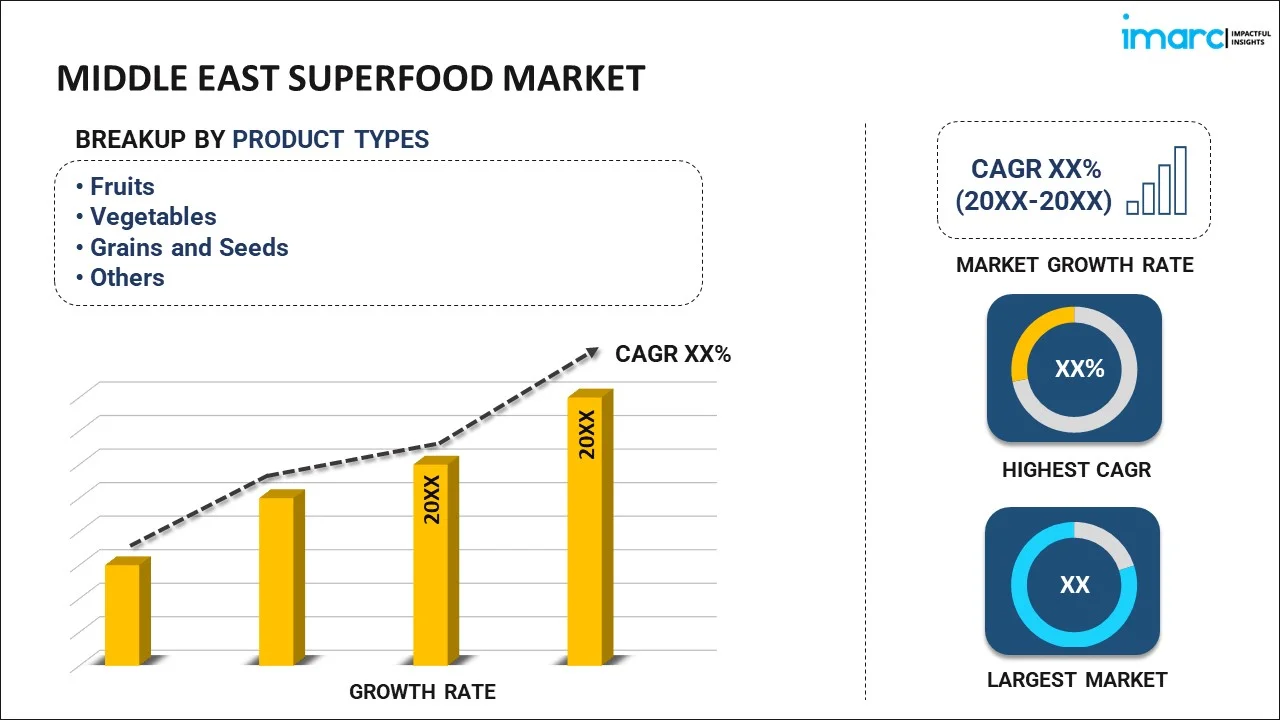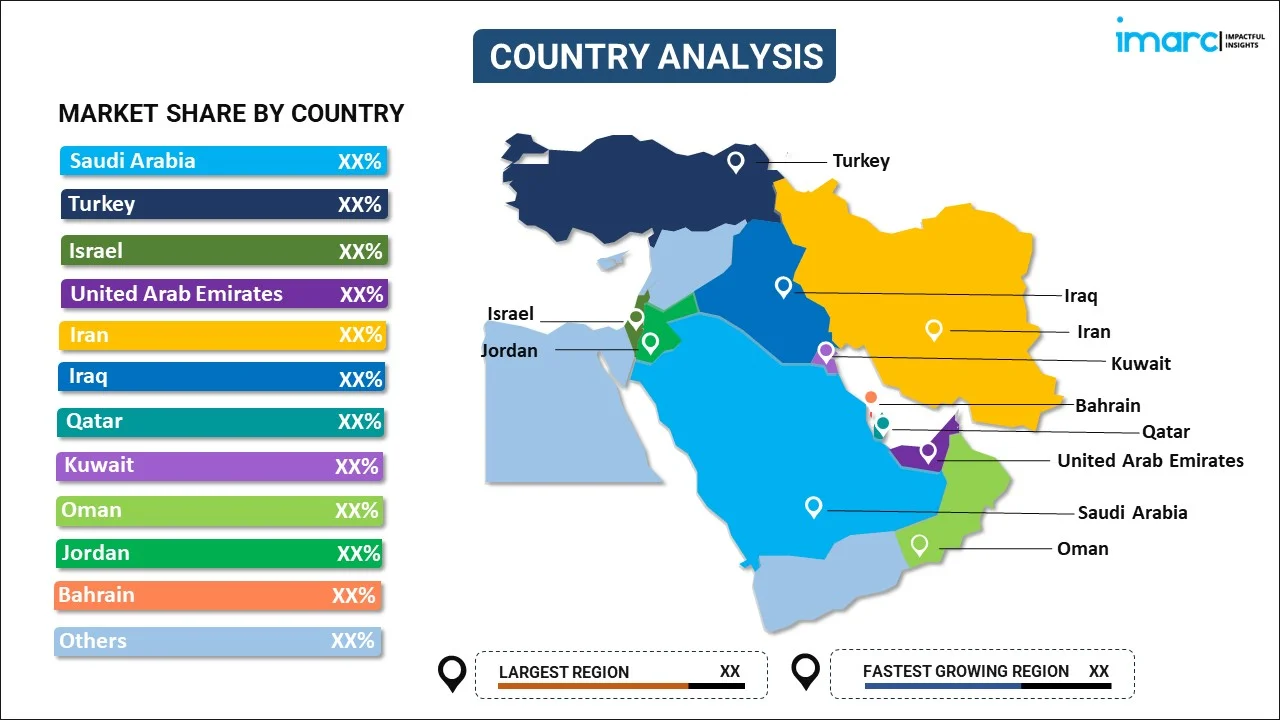
Middle East Superfood Market Report by Product Type (Fruits, Vegetables, Grains and Seeds, Herbs and Roots, Meat, and Others), Application (Bakery and Confectionery, Beverages, Supplements, Convenience/Ready-to-Eat Foods, and Others), Distribution Channel (Supermarkets and Hypermarkets, Convenience Stores, Specialty Stores, Independent Small Grocery Stores, Online Sales, and Others), and Country 2024-2032
Market Overview:
Middle East superfood market size is projected to exhibit a growth rate (CAGR) of 9.40% during 2024-2032. The increasing demand for cloud services and big data analytics, the rising need for more reliable and scalable data processing and storage facilities and stringent regulatory compliance represent some of the key factors driving the market.
|
Report Attribute
|
Key Statistics
|
|---|---|
|
Base Year
|
2023 |
|
Forecast Years
|
2024-2032
|
|
Historical Years
|
2018-2023
|
| Market Growth Rate (2024-2032) | 9.40% |
Superfoods are foods packed with essential nutrients, including vitamins, minerals, antioxidants, and phytonutrients, derived from both plant and animal sources. These nutrient-dense foods contribute significantly to promoting individuals' overall health and well-being, acting as a preventive measure against infections and various diseases. Superfoods encompass a variety of natural ingredients such as fruits, vegetables, grains, nuts, and seeds, all of which are abundant in vital minerals like iron, calcium, and magnesium. Additionally, certain fatty fish like salmon, known for their high omega-3 fatty acid content, fall under the category of superfoods. The consumption of these foods supports the enhancement of the immune system, fosters heart health, and aids in the regulation of blood sugar levels. With their rich nutritional profiles, superfoods have emerged as a key component in fostering a balanced and health-conscious diet.
Middle East Superfood Market Trends:
The Middle East superfood market is experiencing a notable surge, reflecting a growing awareness and preference for nutrient-dense foods that contribute to overall health and well-being. This market embraces a diverse array of superfoods derived from both plant and animal sources, each packed with essential vitamins, minerals, antioxidants, and phytonutrients. Besides this, fruits, vegetables, grains, nuts, and seeds, enriched with minerals like iron, calcium, and magnesium, dominate the landscape of superfoods in the Middle East, which is acting as another significant growth-inducing factor. Additionally, the inclusion of omega-3 fatty acid-rich fatty fish such as salmon exemplifies the region's recognition of the holistic health benefits associated with superfood consumption. As health-conscious lifestyles gain traction in the Middle East, the superfood market is expanding to meet the demand for foods that not only offer preventive health benefits but also align with cultural and dietary preferences. Furthermore, these superfoods play a crucial role in supporting the immune system, promoting heart health, and regulating blood sugar levels, making them integral components of a balanced and health-conscious diet. The Middle East superfood market will signify a harmonious convergence of nutritional awareness, culinary traditions, and a burgeoning interest in holistic well-being over the forecasted period.Top of Form
Middle East Superfood Market Segmentation:
IMARC Group provides an analysis of the key trends in each segment of the market, along with forecasts at the regional and country levels for 2024-2032. Our report has categorized the market based on product type, application, and distribution channel.
Product Type Insights:

- Fruits
- Vegetables
- Grains and Seeds
- Herbs and Roots
- Meat
- Others
The report has provided a detailed breakup and analysis of the market based on the product type. This includes fruits, vegetables, grains and seeds, herbs and roots, meat, and others.
Application Insights:
- Bakery and Confectionery
- Beverages
- Supplements
- Convenience/Ready-to-Eat Foods
- Others
A detailed breakup and analysis of the market based on the application have also been provided in the report. This includes bakery and confectionery, beverages, supplements, convenience/ready-to-eat foods, and others.
Distribution Channel Insights:
- Supermarkets and Hypermarkets
- Convenience Stores
- Specialty Stores
- Independent Small Grocery Stores
- Online Sales
- Others
The report has provided a detailed breakup and analysis of the market based on the distribution channel. This includes supermarkets and hypermarkets, convenience stores, specialty stores, independent small grocery stores, online sales, and others.
Country Insights:

- Saudi Arabia
- Turkey
- Israel
- United Arab Emirates
- Iran
- Iraq
- Qatar
- Kuwait
- Oman
- Jordan
- Bahrain
- Others
The report has also provided a comprehensive analysis of all the major regional markets, which include Saudi Arabia, Turkey, Israel, United Arab Emirates, Iran, Iraq, Qatar, Kuwait, Oman, Jordan, Bahrain, and Others.
Competitive Landscape:
The market research report has also provided a comprehensive analysis of the competitive landscape in the market. Competitive analysis such as market structure, key player positioning, top winning strategies, competitive dashboard, and company evaluation quadrant has been covered in the report. Also, detailed profiles of all major companies have been provided.
Middle East Superfood Market Report Coverage:
| Report Features | Details |
|---|---|
| Base Year of the Analysis | 2023 |
| Historical Period | 2018-2023 |
| Forecast Period | 2024-2032 |
| Units | US$ Million |
| Scope of the Report | Exploration of Historical and Forecast Trends, Industry Catalysts and Challenges, Segment-Wise Historical and Predictive Market Assessment:
|
| Product Types Covered | Fruits, Vegetables, Grains and Seeds, Herbs and Roots, Meat, Others |
| Applications Covered | Bakery and Confectionery, Beverages, Supplements, Convenience/Ready-to-Eat Foods, Others |
| Distribution Channels Covered | Supermarkets and Hypermarkets, Convenience Stores, Specialty Stores, Independent Small Grocery Stores, Online Sales, Others |
| Countries Covered | Saudi Arabia, Turkey, Israel, United Arab Emirates, Iran, Iraq, Qatar, Kuwait, Oman, Jordan, Bahrain, Others |
| Customization Scope | 10% Free Customization |
| Report Price and Purchase Option | Single User License: US$ 3699 Five User License: US$ 4699 Corporate License: US$ 5699 |
| Post-Sale Analyst Support | 10-12 Weeks |
| Delivery Format | PDF and Excel through Email (We can also provide the editable version of the report in PPT/Word format on special request) |
Key Questions Answered in This Report:
- How has the Middle East superfood market performed so far and how will it perform in the coming years?
- What has been the impact of COVID-19 on the Middle East superfood market?
- What is the breakup of the Middle East superfood market on the basis of product type?
- What is the breakup of the Middle East superfood market on the basis of application?
- What is the breakup of the Middle East superfood market on the basis of distribution channel?
- What are the various stages in the value chain of the Middle East superfood market?
- What are the key driving factors and challenges in the Middle East superfood?
- What is the structure of the Middle East superfood market and who are the key players?
- What is the degree of competition in the Middle East superfood market?
Key Benefits for Stakeholders:
- IMARC’s industry report offers a comprehensive quantitative analysis of various market segments, historical and current market trends, market forecasts, and dynamics of the Middle East superfood market from 2018-2032.
- The research report provides the latest information on the market drivers, challenges, and opportunities in the Middle East superfood market.
- Porter's five forces analysis assist stakeholders in assessing the impact of new entrants, competitive rivalry, supplier power, buyer power, and the threat of substitution. It helps stakeholders to analyze the level of competition within the Middle East superfood industry and its attractiveness.
- Competitive landscape allows stakeholders to understand their competitive environment and provides an insight into the current positions of key players in the market.
Need more help?
- Speak to our experienced analysts for insights on the current market scenarios.
- Include additional segments and countries to customize the report as per your requirement.
- Gain an unparalleled competitive advantage in your domain by understanding how to utilize the report and positively impacting your operations and revenue.
- For further assistance, please connect with our analysts.
 Inquire Before Buying
Inquire Before Buying
 Speak to an Analyst
Speak to an Analyst
 Request Brochure
Request Brochure
 Request Customization
Request Customization




.webp)




.webp)












